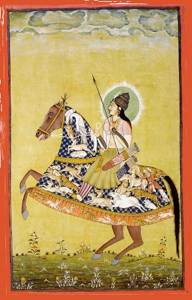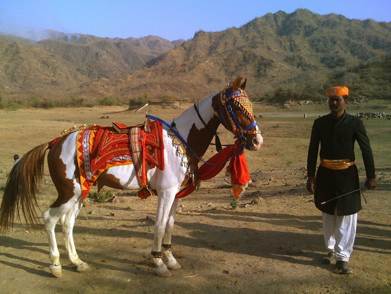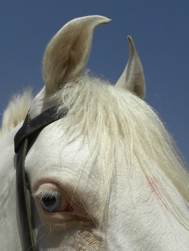The Horses

The Marwari horse of today is descended from the splendid war horses that have served the ruling families and warriors of feudal India. Then, and throughout most of India's history, their status was unparalleled. They were declared divine, and superior to all men, including those of royal blood. Accordingly, only the Rajput families and the Kshatriyas, the warrior caste, were permitted to mount these exalted animals.
It is thanks to the surviving Rajput families and horse lovers from all communities that the resilient and beautiful Marwari has emerged from a period of neglect and the threat of extinction during the years of the British Empire and the early days of Indian democracy.
The Marwari horse is native to the Marwar region of India, its origins entwined with local folklore. According to Shri Mahant Baba Balak Dasji Maharaj, the head Priest of the Monastery at Kalabar, the breed can be traced to a period, "when the ocean was churned to extract nectar for the Gods, a period when horses had wings."
The Rathores, a warrior clan of the Raiputs, were driven from their kingdom of Kannaju around the 12th century. The harsh and desolate land in which they resettled was known as "Maru Pradesh," the land of death, and it required a rugged horse. The native Marwari horse proved well suited for both the desert and its role in battle for the Rathore cavalry.

During the Middle Ages, the principal occupation of the Rathores of Marwar was breeding Marwari horses. Under the reign of the Mogul Emperor Akbar, the Raiputs fielded a force of 50,000 men and horses, and the Marwari horse began famous for bringing back riders who became lost in the desert.
The Marwari breed has long been noted for its exceptional hearing: allowing both horse and rider early warning of impending danger. The brave Raiput went to battle believing there was no better way to die than on the field. And the Marwari became one with their masters. There were only three ways a Marwari cavalry horse left a battlefield: one was when he was victorious; another was when he carried his wounded master to safety; and the last was when he lay down his life for his master.
Caring for Our Marwaris on the Ride

We make every effort to take excellent care of our horses. We usually begin our rides in the morning while it is still cool outside, rest in the heat of the midday, and resume in the late afternoon.
A team of grooms accompanies our caravan. The grooms are responsible for daily feeding and watering of the horses, and maintaining tack in good condition.
Should your horse become injured or fatigued, it will be transported by truck back to the stables to rest and recuperate. Extra horses accompany our caravan in case of any such emergency.
Relief Riders International regularly evaluates the performance of our Indian horse outfitter to ensure the highest standards of care for our horses are being met, and that everyone – including the horses– enjoys a safe and fun ride through the beautiful Rajasthan desert.
The Akhal-Teke of Cappadocia
 The Akhal-Teke is a desert breed of horse that is thought to have descended from an ancient Scythian type. The Akhal-Teke's is thought to descend from the almost gazelle like and light bodied horse of the arid deserts of Central Asia.
The Akhal-Teke is a desert breed of horse that is thought to have descended from an ancient Scythian type. The Akhal-Teke's is thought to descend from the almost gazelle like and light bodied horse of the arid deserts of Central Asia.
The grasses of this region were sparse, although nutritious and along with the extreme heat, a light bodied yet wiry horse had a better chance for survival than slower thicker horse types. The landscape was treeless and open, so a swift horse with stamina, capable of outrunning predators had again the best chance for survival. These desert types were built for speed, they had a "hot" temperament and very quick reactions, and a long body ensured plenty of room for long periods of deep athletic breathing.

These adaptations to the environment served the ancient peoples of the area very well. The Akhal-Teke horses were originally bred as war and raiding, or "Alaman" (translates to raiding) horses which was also naturally suited as a race horse. Its lineage and breeding was kept pure through an oral tradition of maintaining bloodlines and due to the relative isolation of the Teke tribes.
"Akhal" translates to "pure". The horse was so named to identify with the Teke tribe, "Pure Teke". Akhal is also the name of an isolated oasis located in Turkmenistan on the Northern slope of the Kopet-Dag mountain, center for the nomadic Akhal-Teke tribe.